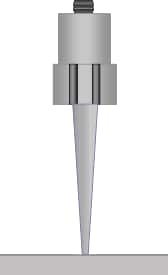Important Knowledge for Acceleration Measurement
This section explains how to fix an acceleration sensor to a cable, an operation that greatly affects the accuracy of acceleration measurement.
How to fix an acceleration sensor in place
There are five major methods to use in fixing an acceleration sensor in place. These methods are shown below.

1. Fixation with a screw
This is the most ideal way to fix an acceleration sensor in place. In order to enhance the stiffness, grease is thinly applied to the measurement target before fixation with the specified tightening torque.

2. Fixation with cement
Cement is applied to the measurement target to fix the acceleration sensor in place. Depending on the adhesion condition, it is possible to obtain performance close to fixation with a screw. This method is mainly used when you do not want to make a screw hole on the measurement target.
In general, epoxy cement is used because soft cement significantly reduces the effective frequency range of the acceleration sensor.

3. Fixation with an insulation washer
This method is used when you want to electrically insulate the acceleration sensor from the measurement target. Depending on the fixation condition, it is possible to obtain performance close to fixation with a screw.

4. Fixation with a magnet
This method is used as an easy fixation method for a measurement target that has a magnetic surface.

5. Fixation with a hand probe
This fixation method is used in a narrow space that does not allow for fixation with a screw or when you want to inspect the target quickly.
This method is very useful but produces large measurement errors.
How to fix a cable in place

Regarding the cable, make sure that excessive force will not be applied to the connector of the acceleration sensor.
Also, ensure that no large vibration will occur.
Failing to follow these instructions will not only prevent you from obtaining satisfactory measurement results, but in the worst case, may also lead to cable disconnection or connector damage.
Be sure to fix the cable in place, ensuring that excessive force is not applied to the cable.




